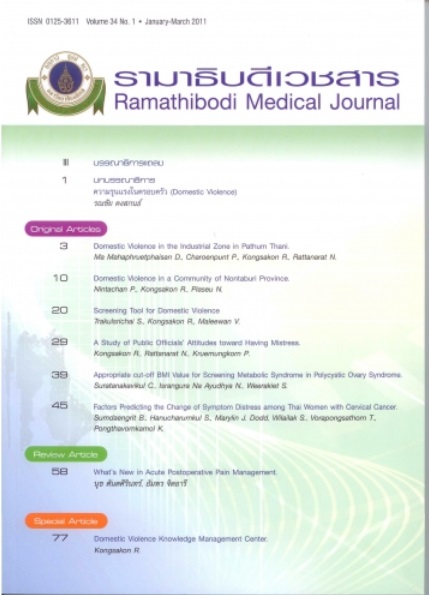Appropriate cut-off BMI Value for Screening Metabolic Syndrome in Polycystic Ovary Syndrome
Main Article Content
Abstract
Objectives: To determine the appropriate cut-off BMI value for screening the metabolic syndrome in polycystic ovary syndrome.
Study design: Retrospective diagnostic test
Subjects: Women with polycystic ovary syndrome who attended the Division of Reproductive Endocrinology, Department of Obstetrics and Gynecology, Faculty of Medicine Ramathibodi Hospital, Mahidol University during Jan 2002 to Feb 2007.
Methods: Data of 190 PCOS women were analyzed. According to the protocol of the Division all women had anthropometric examined and had a 75-g oral glucose tolerance test performed. Also, Blood samples for fasting triglyceride and HDL were obtained. The metabolic syndrome (MS) was diagnosed by the AHA/NHLBI criteria.
Result: Mean age, BMI and WHR were 28.7 ± 5.9 years, 26.2 ± 6.5 kg/m2 and 0.84 ± 0.07, respectively. Prevalence of MS was 28.4%. At the BMI cut-off value of 20 and 23 sensitivity and specificity was 100% both, and 26.47% and 55.51%, respectively. At the higher BMI cut-off value of 27 and 30, sensitivity and specificity of 94.44% and 83.33%, and 78.68% and 90.44%, respectively. At The BMI cut-off value of 25 has sensitivity and specificity of 98.15% and 73.53%, respectively. At this level, 101 (53.15%) women could be eliminated from the metabolic examination and only 89 out of 190 (46.84%) women would be examined. However, at this level, 1 (1.85%) women could be missed in the diagnosis of MS.
Conclusions: The appropriate body mass index cut-off value for screening metabolic syndrome in polycystic ovary syndrome is 25
Article Details
References
Chang RJ, Katz SE. Diagnosis of polycystic ovary syndrome. Endocrinol Metab Clin North Am. 1999;28(2):397-408, vii. doi:10.1016/s0889-8529(05)70076-1.
Conway GS. Polycystic ovary syndrome: clinical aspects. Baillieres Clin Endocrinol Metab. 1996;10(2):263-79. doi:10.1016/s0950-351x(96)80113-3.
Diamanti-Kandarakis E, Kouli CR, Bergiele AT, Filandra FA, Tsianateli TC, Spina GG, et al. A survey of the polycystic ovary syndrome in the Greek island of Lesbos: hormonal and metabolic profile. J Clin Endocrinol Metab. 1999;84(11):4006-11. doi:10.1210/jcem.84.11.6148.
Knochenhauer ES, Key TJ, Kahsar-Miller M, Waggoner W, Boots LR, Azziz R. Prevalence of the polycystic ovary syndrome in unselected black and white women of the southeastern United States: a prospective study. J Clin Endocrinol Metab. 1998;83(9):3078-82. doi:10.1210/jcem.83.9.5090.
Dunaif A. Insulin action in the polycystic ovary syndrome. Endocrinol Metab Clin North Am. 1999;28(2):341-59. doi:10.1016/s0889-8529(05)70073-6.
Holte J. Disturbances in insulin secretion and sensitivity in women with the polycystic ovary syndrome. Baillieres Clin Endocrinol Metab. 1996;10(2):221-47. doi:10.1016/s0950-351x(96)80085-1.
Weerakiet S, Bunnag P, Phakdeekitcharoen B, Wansumrith S, Chanprasertyothin S, Jultanmas R, et al. Prevalence of the metabolic syndrome in Asian women with polycystic ovary syndrome: using the International Diabetes Federation criteria. Gynecol Endocrinol. 2007;23(3):153-60. doi:10.1080/09513590701214158.
National Cholesterol Education Program (NCEP) Expert Panel on Detection, Evaluation, and Treatment of High Blood Cholesterol in Adults (Adult Treatment Panel III). Third Report of the National Cholesterol Education Program (NCEP) Expert Panel on Detection, Evaluation, and Treatment of High Blood Cholesterol in Adults (Adult Treatment Panel III) final report. Circulation. 2002;106(25):3143-421.
Alberti KG, Zimmet P, Shaw J; IDF Epidemiology Task Force Consensus Group. The metabolic syndrome--a new worldwide definition. Lancet. 2005;366(9491):1059-62. doi:10.1016/S0140-6736(05)67402-8.
Reaven GM. Banting lecture 1988. Role of insulin resistance in human disease. Diabetes. 1988;37(12):1595-607. doi:10.2337/diab.37.12.1595.
Groop L, Orho-Melander M. The dysmetabolic syndrome. J Intern Med. 2001;250(2):105-20. doi:10.1046/j.1365-2796.2001.00864.x.
DeFronzo RA, Ferrannini E. Insulin resistance. A multifaceted syndrome responsible for NIDDM, obesity, hypertension, dyslipidemia, and atherosclerotic cardiovascular disease. Diabetes Care. 1991;14(3):173-94. doi:10.2337/diacare.14.3.173.
Hanley AJ, Williams K, Stern MP, Haffner SM. Homeostasis model assessment of insulin resistance in relation to the incidence of cardiovascular disease: the San Antonio Heart Study. Diabetes Care. 2002;25(7):1177-84. doi:10.2337/diacare.25.7.1177.
Kip KE, Marroquin OC, Kelley DE, Johnson BD, Kelsey SF, Shaw LJ, et al. Clinical importance of obesity versus the metabolic syndrome in cardiovascular risk in women: a report from the Women's Ischemia Syndrome Evaluation (WISE) study. Circulation. 2004;109(6):706-13. doi:10.1161/01.CIR.0000115514.44135.A8.
Turhan H, Yasar AS, Erbay AR, Yetkin E, Sasmaz H, Sabah I. Impaired coronary collateral vessel development in patients with metabolic syndrome. Coron Artery Dis. 2005;16(5):281-5. doi:10.1097/00019501-200508000-00004.
Glueck CJ, Papanna R, Wang P, Goldenberg N, Sieve-Smith L. Incidence and treatment of metabolic syndrome in newly referred women with confirmed polycystic ovarian syndrome. Metabolism. 2003;52(7):908-15. doi:10.1016/s0026-0495(03)00104-5.
Rotterdam ESHRE/ASRM-Sponsored PCOS consensus workshop group. Revised 2003 consensus on diagnostic criteria and long-term health risks related to polycystic ovary syndrome (PCOS). Hum Reprod. 2004;19(1):41-7. doi:10.1093/humrep/deh098.
Grundy SM, Cleeman JI, Daniels SR, Donato KA, Eckel RH, Franklin BA, et al. Diagnosis and management of the metabolic syndrome: an American Heart Association/National Heart, Lung, and Blood Institute Scientific Statement. Circulation. 2005;112(17):2735-52. doi:10.1161/CIRCULATIONAHA.105.169404.
Apridonidze T, Essah PA, Iuorno MJ, Nestler JE. Prevalence and characteristics of the metabolic syndrome in women with polycystic ovary syndrome. J Clin Endocrinol Metab. 2005;90(4):1929-35. doi:10.1210/jc.2004-1045.
Chen X, Ni R, Mo Y, Li L, Yang D. Appropriate BMI levels for PCOS patients in Southern China. Hum Reprod. 2010;25(5):1295-302. doi:10.1093/humrep/deq028.
